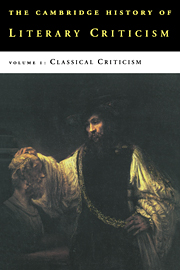Book contents
- Frontmatter
- 1 Early Greek views of poets and poetry
- 2 Language and meaning in archaic and classical Greece
- 3 Plato and poetry
- 4 Aristotle's poetics
- 5 The evolution of a theory of artistic prose
- 6 Hellenistic literary and philosophical scholarship
- 7 The growth of literature and criticism at Rome
- 8 Augustan Critics
- 9 Latin Criticism of the Early Empire
- 10 Greek Criticism of the Empire
- 11 Christianity and Criticism
- Bibliography
- Index
- References
8 - Augustan Critics
Published online by Cambridge University Press: 28 March 2008
- Frontmatter
- 1 Early Greek views of poets and poetry
- 2 Language and meaning in archaic and classical Greece
- 3 Plato and poetry
- 4 Aristotle's poetics
- 5 The evolution of a theory of artistic prose
- 6 Hellenistic literary and philosophical scholarship
- 7 The growth of literature and criticism at Rome
- 8 Augustan Critics
- 9 Latin Criticism of the Early Empire
- 10 Greek Criticism of the Empire
- 11 Christianity and Criticism
- Bibliography
- Index
- References
Summary
The Augustan period includes two major critics, Horace and Dionysius, both important in themselves but also in part conveniently complementary and typical. Horace is both poet and critic, a Roman deeply conscious of Rome's literary debt to Greece, yet also a champion of new Roman poetry. The historian and rhetorician Dionysius of Halicarnassus is also practitioner as well as critic, but he is primarily concerned with prose, especially oratory, though poetry has an important place in his most original work, On Composition. A Greek, he too is conscious of the Greek past, yet within a framework of Classicism in his assertion of canons of past greatness he displays a confident optimism about the present. But though living in Rome by 30 BC and in some works addressing Romans, he shows no interest in Roman literature; quite exceptionally in the preface to On Ancient Orators he refers to the influence of good Roman taste on the victory of Greek Atticism over Asianism.
Dionysius is here entirely typical of Greek lack of interest in Roman literature. By the late Republic and Augustan period Rome was a magnet to Greek men of letters as a centre of power and patronage; almost every Augustan Greek writer was in Rome for a substantial part of his life, and Greek works were often dedicated to Roman patrons. But Greek literary criticism expounds Greek theory and literature, and the basic relationship is of Greece instructing Rome, sometimes explicitly so, for example when Dionysius dedicates On Composition to the young Metilius Rufus, promises him the gift of a second work on diction so that he will be better instructed, and refers to their daily instruction together (Comp. 1, 20, 26).
- Type
- Chapter
- Information
- The Cambridge History of Literary Criticism , pp. 245 - 273Publisher: Cambridge University PressPrint publication year: 1990

